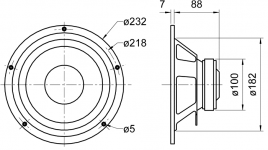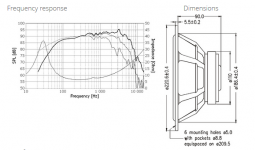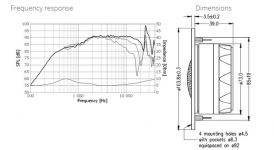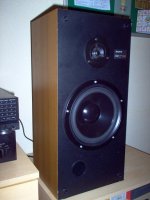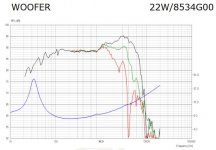You can improve the existing cabs with dowels and good quality rockwool insulation. I wouldnt go crazy on the drivers- but you can improve on the existing ones for sure!
Sorry, nobody has answered what I asked.
How about buying an old "classic" speaker and rebuilding it?
Refoam woofers, new crossover parts, refinish cabinet, etc.
I have replaced drivers in speakers in the past with mixed results. I'm not sure I knew what I was doing in those days.
How about buying an old "classic" speaker and rebuilding it?
Refoam woofers, new crossover parts, refinish cabinet, etc.
This is something I have considered. My limitation is space. I live in a condo where I don't have room for big speakers. Most of the "classic" vintage speakers have big cabinets. Tannoy, Whaferdale, Altec, AR, Infinity, etc.
I have space for bookshelf in one room. I want another pair to set up an hybrid system (tube/ss) I already own a pair of Monitor Audio Silver S2 that can live with them. They sound decent powered by my vintage Sansui AU-517 and an Arcam cd player.
I don't want bookshelf with a woofer smaller than 8". For me, the side of the speaker matters. 8" is the minimum I accept for a bass driver. I bought a Rogue Audio Tube integrated and have a Pioneer Elite cd player to pair with it. I don't want to buy another bookshelf from any brand. I want to build them. I don't want to buy a kit with Dayton drivers. I want something better. Anyway, thanks for all.! At the end, this is for fun and entertainment.
dvjorge,
As I am advocate for open baffle design, no cabinet needed, you can chop and change as much as you like with all kinds of drivers both big and small. If you can make do with a moderate subwoofer to support the lower end of the spectrum you can use baffle sizes from minute to large, its all part of the design process. It puts you on a learning curve that will enable you experiment for yourself, and there are many free software programs that will help with that. There is the column above and there are many here that will help you through it all.
Ultimate Open Baffle Gallery
Merry Christmas to all.
C.M
As I am advocate for open baffle design, no cabinet needed, you can chop and change as much as you like with all kinds of drivers both big and small. If you can make do with a moderate subwoofer to support the lower end of the spectrum you can use baffle sizes from minute to large, its all part of the design process. It puts you on a learning curve that will enable you experiment for yourself, and there are many free software programs that will help with that. There is the column above and there are many here that will help you through it all.
Ultimate Open Baffle Gallery
Merry Christmas to all.
C.M
Last edited:
Anyway, according to the answers so far, an speaker can not be upgraded with new drivers. Thanks for advising.! By the way, nobody has answered what I asked.
Box, crossover and drivers are all inter-related. Yes, you can buy a good looking speaker and replace the drivers and the crossover. If you knew how to design the crossover, you should know how to handle the existing box.
Or may be you are thinking about using drivers and crossovers from a specific design and you want only change the enclosure? It is possible (not really crazy), as the box mainly determine the roll-off frequency. All other parameters (distance between tweeter-woofer, the offset and size of the baffle) are less critical.
You can seal the box (mostly they are vented, aren't they?) and get a much higher roll-off frequency (it means less bass, so you need a bigger box here). Or, you can design a new port (length) for the box by cutting the original tube (if you need shorter one) or replace with longer one (if the driver and the box need a longer one).
Maybe get a half-decent vintage speaker and just apply slight upgrades?
For drivers, the duct seal thing is a good start:
Speaker Tweeks -- Puzzlecoat & Ductseal
For cabinets:
+1 on what Bill poster said. Also, check out this list. This is damping factors of different materials:
damping factor values - audio qualia
Note that most of the "complex" materials have much better damping than the commonly used "wood" materials at the top of the page, such as MDF and ply.
e.g. 'Page Lacquer' acrylic over mdf is on their complex list. It is a cheap, humble combination, but it has substantially better damping than MDF (or ply) alone.
...the implication being that laminating a non-wood layer onto a poverty cabinet should give better results (more damping / less sound transmission through the walls) than building an simple cabinet with premium plywood.
Because science.
If you do decide to upgrade drivers, my tip is to download REW and invest a few dollars in a test mic, otherwise you'll waste a lot of time.
For drivers, the duct seal thing is a good start:
Speaker Tweeks -- Puzzlecoat & Ductseal
For cabinets:
+1 on what Bill poster said. Also, check out this list. This is damping factors of different materials:
damping factor values - audio qualia
Note that most of the "complex" materials have much better damping than the commonly used "wood" materials at the top of the page, such as MDF and ply.
e.g. 'Page Lacquer' acrylic over mdf is on their complex list. It is a cheap, humble combination, but it has substantially better damping than MDF (or ply) alone.
...the implication being that laminating a non-wood layer onto a poverty cabinet should give better results (more damping / less sound transmission through the walls) than building an simple cabinet with premium plywood.
Because science.
If you do decide to upgrade drivers, my tip is to download REW and invest a few dollars in a test mic, otherwise you'll waste a lot of time.
You seem set on using pre built enclosures...do you not have the means, time or know-how to construct your own? I'm just trying to understand so I can better answer. Your analogy about the Kia and BMW may be a little off as tuning and enclosure quality play a huge role in the speakers sound. Most of the boxes for speakers I see at thrift stores are crappy, unbraced flake board (there are rare exceptions).
Most of the boxes for speakers I see at thrift stores are crappy, unbraced flake board (there are rare exceptions).
Sometimes they are pretty (though technically crappy) for their price. Imagine a $100 speaker with pretty box and crappy drivers. What kind of tailor-made box can you get with $100?
But there is another solution to get a pretty box easily. Just order a cheap rectangular box. Wrap it with synthetic leather.
I'm taking a shot with a 20l cabinet tuned very low with Peerless 830869 and SB26ADC-04 alu dome tweeter this holiday season. I'll start a new thread when it's complete.
The reason for the small cabinet is that the application has a subwoofer per channel, compact size matters more than low-end extension.
The reason for the small cabinet is that the application has a subwoofer per channel, compact size matters more than low-end extension.
Imagine a $100 speaker with pretty box and crappy drivers.
Well, there's a $1000 sonus faber bookshelf design with v basic drivers(the tweeters are fairly crappy)
I usually carry a tape measure when looking at a potential cheapie cabinet. This Sony E44 looked ideal diy territory at around 30L or a cubic foot for 8" plus 1". The reflex port can be made bigger, because the original is tuned quite high, being high efficiency.
Tweeters tend to be 94mm (like the Visaton DT94 below) or 104 mm. Chipboard cabinets are improved by sticking rubbery/damping stuff to the side panels. Carpet tiles will do.
Crossovers can be simple or complex. According to Joachim Gerhard, the SEAS U22 and DXT drivers willl work on simple cap and coil, but we can do better.
Have a go. Always happy to help with crossover when nearer the final design, but really any flattish drivers will be good. Below is 1st order bass with some impedance correction, 3rd order BW3 tweeter. The Sony original was mere 3.3uF tweeter and it sounded like it.
Tweeters tend to be 94mm (like the Visaton DT94 below) or 104 mm. Chipboard cabinets are improved by sticking rubbery/damping stuff to the side panels. Carpet tiles will do.
Crossovers can be simple or complex. According to Joachim Gerhard, the SEAS U22 and DXT drivers willl work on simple cap and coil, but we can do better.
Have a go. Always happy to help with crossover when nearer the final design, but really any flattish drivers will be good. Below is 1st order bass with some impedance correction, 3rd order BW3 tweeter. The Sony original was mere 3.3uF tweeter and it sounded like it.
Attachments
Last edited:
You seem set on using pre built enclosures...do you not have the means, time or know-how to construct your own? I'm just trying to understand so I can better answer. Your analogy about the Kia and BMW may be a little off as tuning and enclosure quality play a huge role in the speakers sound. Most of the boxes for speakers I see at thrift stores are crappy, unbraced flake board (there are rare exceptions).
Paul, thank for your answer. Yes, I can build the enclosures by myself. In fact, I am very good finishing.. (the look is important to me) I worked as an auto body shop technician for years, so I can paint them high gloss if I want. As you may realize, I am new in this world, so before to do anything, I need to read, to learn, to consult how to begin with all this. I also can order the wood work using a local wood shop that I know they work well. If they build the enclosures, I will take care of the finish part. However, I will love to build all by myself. What I don't have is a table saw, then I will pay someone who cut the pieces.
I usually carry a tape measure when looking at a potential cheapie cabinet. This Sony E44 looked ideal diy territory at around 30L or a cubic foot for 8" plus 1". The reflex port can be made bigger, because the original is tuned quite high, being high efficiency.
Tweeters tend to be 94mm (like the Visaton DT94 below) or 104 mm. Chipboard cabinets are improved by sticking rubbery/damping stuff to the side panels. Carpet tiles will do.
Crossovers can be simple or complex. According to Joachim Gerhard, the SEAS U22 and DXT drivers willl work on simple cap and coil, but we can do better.
Have a go. Always happy to help with crossover when nearer the final design, but really any flattish drivers will be good. Below is 1st order bass with some impedance correction, 3rd order BW3 tweeter. The Sony original was mere 3.3uF tweeter and it sounded like it.
Thank you for you cooperation. After I learn more, (reading and researching) I probably come back with some more questions.
Last edited:
Hi all,
Can a set of speakers with low quality drivers be upgraded using quality drivers ??
Thanks for reading and excuse me if this is totally nonsense. I think about having a basic KIA with an BMW engine and transmission.
Sure it can, bearing in mind that transmission in this parabole is XO filter which probably isn't ready made yet for some arbitrary unknown drivers. Does anyone remember what motor and transmission Gas Monkey Garage istalled in a Corvette, I don't remember what model, and then performed a race against a factory one and lost by maybe 20 meters or something like that? Not bad considering the price difference. Yes, it can be done.
The Scanspeak 22W 8534 G00 is hopeless for a two way! That peak is at 3kHz, but worse is the 6dB SPL rise above 1kHz. That will muck up any attempt at a simple filter, and ruin impedance.
Don't waste time on it. Except in a three way crossing near 500Hz.
Most SEAS 8" are also more suitable. WOOFERS
Don't waste time on it. Except in a three way crossing near 500Hz.
Most SEAS 8" are also more suitable. WOOFERS
Attachments
Last edited:
Hello @All
Thanks for that!
As the 22W/4534G00 shows the same behavior I can tell you that these drivers work extremly well in a two way enclosure, if not crossed higher than ~2kHz.
The Crossover for Suzie was not complicated at all. No notch or anything unusual needed.
The 3kHz peak (in my measurements it is higher @~3,8kHz) does not show neither in burst decay nor in distortions.
In fact I regard these drivers as extremly good midwoofers.
Kind regards
Alexander
Tweeter and crossover are properly selected by someone who knows what he is doing. 🙂
Thanks for that!
The Scanspeak 22W 8534 G00 is hopeless for a two way! That peak is at 3kHz, but worse is the 6dB SPL rise above 1kHz. That will muck up any attempt at a simple filter, and ruin impedance.
As the 22W/4534G00 shows the same behavior I can tell you that these drivers work extremly well in a two way enclosure, if not crossed higher than ~2kHz.
The Crossover for Suzie was not complicated at all. No notch or anything unusual needed.
The 3kHz peak (in my measurements it is higher @~3,8kHz) does not show neither in burst decay nor in distortions.
In fact I regard these drivers as extremly good midwoofers.
Kind regards
Alexander
Hello @All
Thanks for that!
As the 22W/4534G00 shows the same behavior I can tell you that these drivers work extremly well in a two way enclosure, if not crossed higher than ~2kHz.
The Crossover for Suzie was not complicated at all. No notch or anything unusual needed.
The 3kHz peak (in my measurements it is higher @~3,8kHz) does not show neither in burst decay nor in distortions.
In fact I regard these drivers as extremly good midwoofers.
Kind regards
Alexander
Thanks for taking your time to answer. I love the size of your enclosures (saw the picture) however, I am not sure a textile dome tweeter is proper to my taste. I am a listener that needs plenty of high frequency details. A rolled up tweeter (or crossover) is not what I am looking for. I want an slightly bright tweeter (to call it in a way) I don't like distorted treble or sibilance but can not live with a dark speaker either. Just my preference but not telling one way is better than the other. However, I can not live with an overly bright tweeter either. Of the materials I have listened to, aluminum is the best for my taste. I find titanium too bright as well as beryllium. Silk and soft domes, rolled off. I don't know if the culprit were the crossovers or tweeter materials.
The Scanspeak 22W 8534 G00 is hopeless for a two way! That peak is at 3kHz, but worse is the 6dB SPL rise above 1kHz. That will muck up any attempt at a simple filter, and ruin impedance.
Don't waste time on it. Except in a three way crossing near 500Hz.
Most SEAS 8" are also more suitable. WOOFERS
Thank you so much for your help. I need you all since I am learning. The speakers will be done and hope, after this forum advice, they will sound good.!
Cutting frequency (2 way speakers)
Hi everyone,
Reading some of the answers many of you have given me in my other post, has generated a question. I am new, as many of you have noticed, however, since I have a background as a Telecom Engineer, I understand any technical explanation or electrical terms. So, don't be afraid to explain, you aren't losing your time and I appreciate it.
The question is : Cutting a two way speaker system at 2000 hz don't compromise the tweeter performance since more mid-frequency is reaching the tweeter ?? Common tweeters have an small diaphragm, 1" most of the time. I don't know if they can handle lower mid frequency without adding distortion or sacrificing higher frequencies clarity.
Remember, I am learning and in my ignorant view, the midwoofer is better suited to handle mid and low frequencies and you can leave the tweeter less saturated. So, cutting the crossover as high as possible isn't better ??
Correct me if I am wrong. I really appreciate your collaboration.!
Thanks.!
Hi everyone,
Reading some of the answers many of you have given me in my other post, has generated a question. I am new, as many of you have noticed, however, since I have a background as a Telecom Engineer, I understand any technical explanation or electrical terms. So, don't be afraid to explain, you aren't losing your time and I appreciate it.
The question is : Cutting a two way speaker system at 2000 hz don't compromise the tweeter performance since more mid-frequency is reaching the tweeter ?? Common tweeters have an small diaphragm, 1" most of the time. I don't know if they can handle lower mid frequency without adding distortion or sacrificing higher frequencies clarity.
Remember, I am learning and in my ignorant view, the midwoofer is better suited to handle mid and low frequencies and you can leave the tweeter less saturated. So, cutting the crossover as high as possible isn't better ??
Correct me if I am wrong. I really appreciate your collaboration.!
Thanks.!
- Home
- Loudspeakers
- Multi-Way
- Building a two way bookshelf

